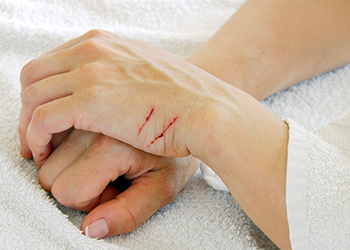Cuts and Scrapes
Self-care for Simple Wounds:

Carefully clean the wound with water and do not use soap, as it might irritate the wound. After that, if there are foreign objects (dirt), use sterilized tweezers to remove them. See your doctor, if they remain in the wound. Make sure the area around the wounds is cleaned as well; you can use soap but make sure it doesn't get into the wound.
If the cut or scrape is minor, it will normally stop bleeding on its own, but if it doesn’t, use a clean cloth or bandage and place gentle pressure on the wound continuously for 20 to 30 minutes. Try not to check every few minutes to see if the bleeding has stopped because this may damage any clot that has begun to form and the bleeding will resume. If there’s more blood or if it cannot be stopped after applying continuous pressure, seek emergency medical assistance.
Apply an antibiotic cream or ointment to help keep the surface moist and prevent infection. It might not heal you sooner, but will help your body to complete the healing process without any complications. Some people are allergic to antibiotic creams and ointments, so if a rash appears, stop using the ointment.
Cover the wound with bandages to keep the wound clean and keep out bacteria.
Change the dressing everyday or when it gets soiled. If you have an allergy to the adhesive, get adhesive-free bandages or use sterile gauze held down with tape, a gauze roll, or loosely wrapped elastic bandage.
Once the wound has healed enough that infection is not likely, you should take the bandage off as exposing the wound to the air would speed up the healing.
You might need emergency medical care if the wound won't close easily. You will require professional medical care if the cuts are serious (more than 6 millimeters deep, gaping, has jagged edges, or has fat or muscle protruding). Watch for signs of infection and if wound isn't healing or you notice any redness, increasing pain, drainage, warmth or swelling.
If the wound is deep or dirty and you have not had a tetanus shot within the past five years get a tetanus booster within 48 hours of the injury. It is recommended that you get one every 10 years.
For deeper wounds you need emergency medical help. Do not try to clean major wounds or move objects in them. Try to slow down the heavy bleeding and get medical help.
....................................................................................
This information is provided by the NGHA Content Advisory Board and is not intended to replace the medical advice of your health care provider.